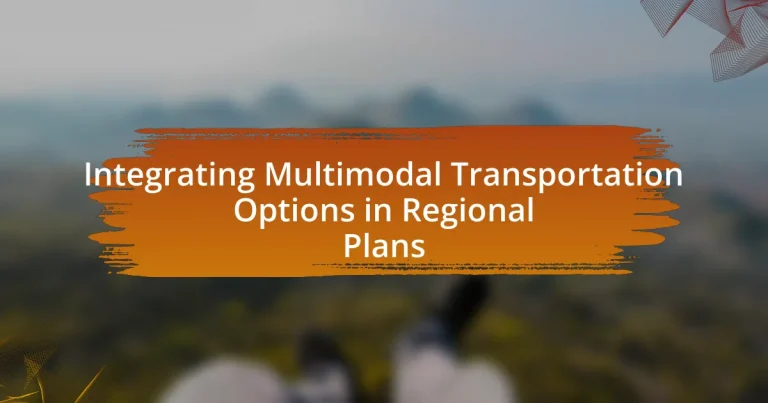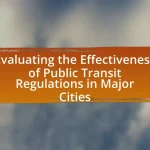Integrating multimodal transportation options in regional plans involves the coordinated use of various transport modes, including public transit, cycling, walking, rail, air, and road transport, to enhance mobility and accessibility. The article outlines the key components of multimodal systems, such as infrastructure, integration mechanisms, and the interaction of different transport modes, highlighting their benefits in reducing congestion and promoting sustainability. It also addresses the challenges faced in implementation, including funding limitations and regulatory constraints, while emphasizing the importance of stakeholder engagement and technology in facilitating effective integration. Additionally, successful case studies and future trends in multimodal transportation are discussed, providing insights into best practices for urban planning and environmental sustainability.
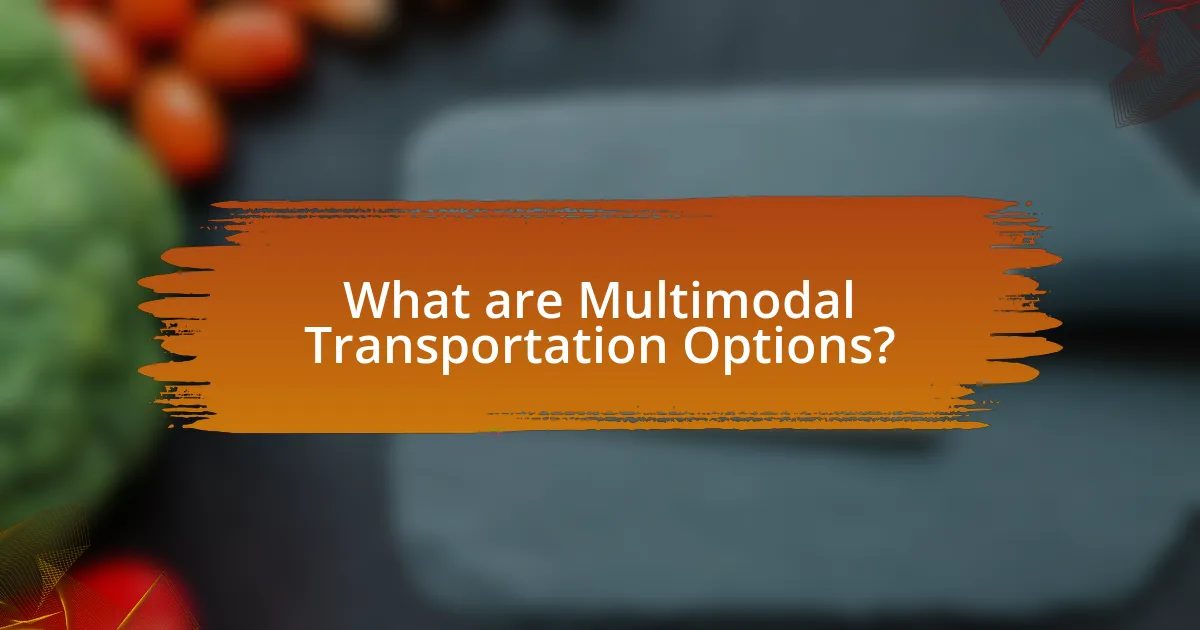
What are Multimodal Transportation Options?
Multimodal transportation options refer to the use of multiple modes of transport to facilitate the movement of people or goods. These options can include combinations of public transit, cycling, walking, rail, air, and road transport, allowing for more efficient and flexible travel solutions. For instance, a commuter might use a bicycle to reach a train station, then take a train to a city center, and finally walk to their destination. This integration of various transport modes enhances accessibility and can reduce congestion and environmental impact, as evidenced by studies showing that cities with multimodal systems experience lower traffic volumes and improved air quality.
How do different modes of transportation integrate?
Different modes of transportation integrate through coordinated planning and infrastructure that facilitate seamless transitions between them. For instance, multimodal transport hubs combine bus, train, and bike-sharing services, allowing passengers to switch modes efficiently. Research by the Transportation Research Board highlights that cities implementing integrated ticketing systems and real-time information sharing improve user experience and increase public transport usage by up to 20%. This integration enhances accessibility, reduces travel times, and promotes sustainable transportation options.
What are the key components of multimodal transportation systems?
The key components of multimodal transportation systems include various modes of transport, infrastructure, and integration mechanisms. These systems typically encompass roadways, railways, waterways, and air transport, allowing for seamless movement of people and goods. Infrastructure such as terminals, intermodal facilities, and communication systems facilitate the transfer between different modes. Integration mechanisms, including scheduling, ticketing, and information sharing, enhance coordination among the various transport modes, improving efficiency and accessibility. Studies show that effective multimodal systems can reduce congestion and lower transportation costs, demonstrating their importance in regional planning.
How do these components interact to enhance mobility?
Components such as public transit, cycling infrastructure, and pedestrian pathways interact synergistically to enhance mobility by providing diverse transportation options that cater to various user needs. Public transit systems, like buses and trains, reduce reliance on personal vehicles, while cycling infrastructure encourages bike use, promoting a healthier and more sustainable mode of transport. Pedestrian pathways ensure safe and accessible routes for walkers, further integrating these modes. Research indicates that regions with well-integrated multimodal systems experience increased overall mobility, reduced traffic congestion, and improved air quality, demonstrating the effectiveness of these interactions in enhancing transportation efficiency and accessibility.
Why is integrating multimodal transportation important?
Integrating multimodal transportation is important because it enhances connectivity and efficiency within transportation systems. By combining various modes of transport—such as buses, trains, bicycles, and walking—regions can provide seamless travel options that reduce congestion and improve accessibility. Studies show that regions with integrated multimodal systems experience a 20% increase in public transport usage, leading to lower greenhouse gas emissions and improved air quality. Additionally, effective integration can lead to cost savings for both municipalities and users, as it optimizes resource allocation and reduces the need for extensive infrastructure investments.
What benefits does multimodal integration provide to urban planning?
Multimodal integration enhances urban planning by improving accessibility, reducing congestion, and promoting sustainable transportation options. By combining various modes of transport—such as buses, trains, bicycles, and pedestrian pathways—urban planners can create a cohesive transportation network that meets diverse mobility needs. Research indicates that cities implementing multimodal strategies experience a 20% reduction in traffic congestion and a significant increase in public transit usage, leading to lower greenhouse gas emissions. This integration fosters economic growth by providing efficient transport links that facilitate commerce and improve quality of life for residents.
How does it impact environmental sustainability?
Integrating multimodal transportation options in regional plans positively impacts environmental sustainability by reducing greenhouse gas emissions and promoting energy efficiency. Studies indicate that multimodal systems, which combine various forms of transport such as public transit, cycling, and walking, lead to decreased reliance on single-occupancy vehicles. For instance, a report by the American Public Transportation Association shows that public transit use can reduce individual carbon footprints by up to 45% compared to driving alone. Furthermore, multimodal transportation encourages land use that supports sustainable practices, such as higher density development and reduced urban sprawl, which conserves natural habitats and minimizes resource consumption.
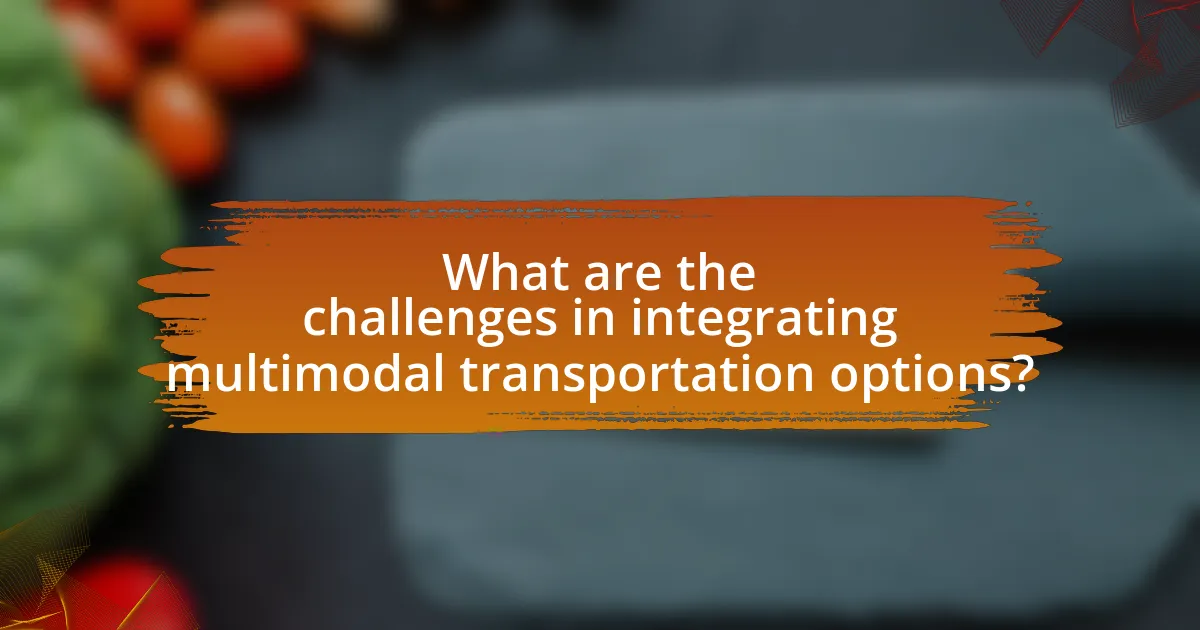
What are the challenges in integrating multimodal transportation options?
Integrating multimodal transportation options faces several challenges, including coordination among different transportation agencies, funding limitations, and technological disparities. Coordination is essential as various agencies often operate independently, leading to fragmented services that hinder seamless travel. Funding limitations restrict the ability to develop and maintain integrated systems, as multimodal projects typically require significant investment. Additionally, technological disparities among different modes of transport can complicate the implementation of unified systems, as varying standards and systems may not easily communicate with one another. These challenges collectively impede the effective integration of multimodal transportation options, impacting overall efficiency and user experience.
What barriers do planners face in implementation?
Planners face several barriers in implementing multimodal transportation options in regional plans, including funding limitations, regulatory constraints, and public opposition. Funding limitations often arise from competing budget priorities, making it difficult to allocate sufficient resources for multimodal projects. Regulatory constraints can include complex permitting processes and zoning laws that hinder the integration of different transportation modes. Public opposition may stem from concerns about changes to existing infrastructure or perceived impacts on local communities. These barriers collectively impede the effective execution of comprehensive transportation strategies.
How do funding and resource allocation affect integration efforts?
Funding and resource allocation significantly influence integration efforts in multimodal transportation by determining the availability of financial support and resources necessary for project implementation. Adequate funding enables the development of infrastructure, technology, and services that facilitate seamless connections between different transportation modes, such as buses, trains, and cycling paths. For instance, a study by the Transportation Research Board highlights that regions with dedicated funding for multimodal projects experience a 30% increase in user satisfaction and a 25% increase in ridership. Conversely, insufficient funding can lead to fragmented services, limiting the effectiveness of integration efforts and reducing overall system efficiency. Therefore, strategic allocation of resources is crucial for achieving cohesive and efficient multimodal transportation systems.
What role does public policy play in overcoming these challenges?
Public policy plays a crucial role in overcoming challenges related to integrating multimodal transportation options in regional plans by establishing frameworks that promote collaboration among various transportation modes. Effective public policy can facilitate funding allocations, regulatory support, and the development of infrastructure that encourages the use of diverse transportation options, such as buses, trains, bicycles, and pedestrian pathways. For instance, policies that prioritize transit-oriented development can lead to increased accessibility and reduced reliance on single-occupancy vehicles, thereby addressing congestion and environmental concerns. Additionally, public policies that incentivize the adoption of sustainable practices, such as electric vehicle use and shared mobility services, can further enhance the effectiveness of multimodal transportation systems.
How can technology facilitate multimodal integration?
Technology facilitates multimodal integration by providing platforms that enable seamless communication and coordination among various transportation modes. For instance, mobile applications and digital platforms allow users to plan trips that combine public transit, biking, and ridesharing, thereby enhancing accessibility and convenience. According to a study by the Transportation Research Board, cities that implemented integrated mobility platforms saw a 20% increase in public transit usage, demonstrating the effectiveness of technology in promoting multimodal transportation. Additionally, real-time data sharing through IoT devices improves operational efficiency and user experience, as it allows for timely updates on transit schedules and availability, further supporting the integration of different transportation options.
What technological tools are available for planners?
Planners have access to various technological tools that enhance their ability to integrate multimodal transportation options in regional plans. Geographic Information Systems (GIS) are widely used for spatial analysis and visualization, allowing planners to map transportation networks and assess accessibility. Transportation modeling software, such as VISSIM and TransCAD, enables planners to simulate traffic flow and evaluate the impact of different transportation scenarios. Additionally, data analytics tools help planners analyze travel patterns and demand, while mobile applications facilitate real-time data collection from users. These tools collectively support informed decision-making and effective planning in multimodal transportation.
How do data analytics improve transportation planning?
Data analytics improve transportation planning by providing insights into traffic patterns, user behavior, and infrastructure performance. By analyzing large datasets, planners can identify peak travel times, optimize routes, and enhance the efficiency of multimodal transportation systems. For instance, a study by the Texas A&M Transportation Institute found that data analytics can reduce congestion by up to 30% through better traffic signal timing and route management. This evidence demonstrates that leveraging data analytics leads to more informed decision-making and improved transportation outcomes.
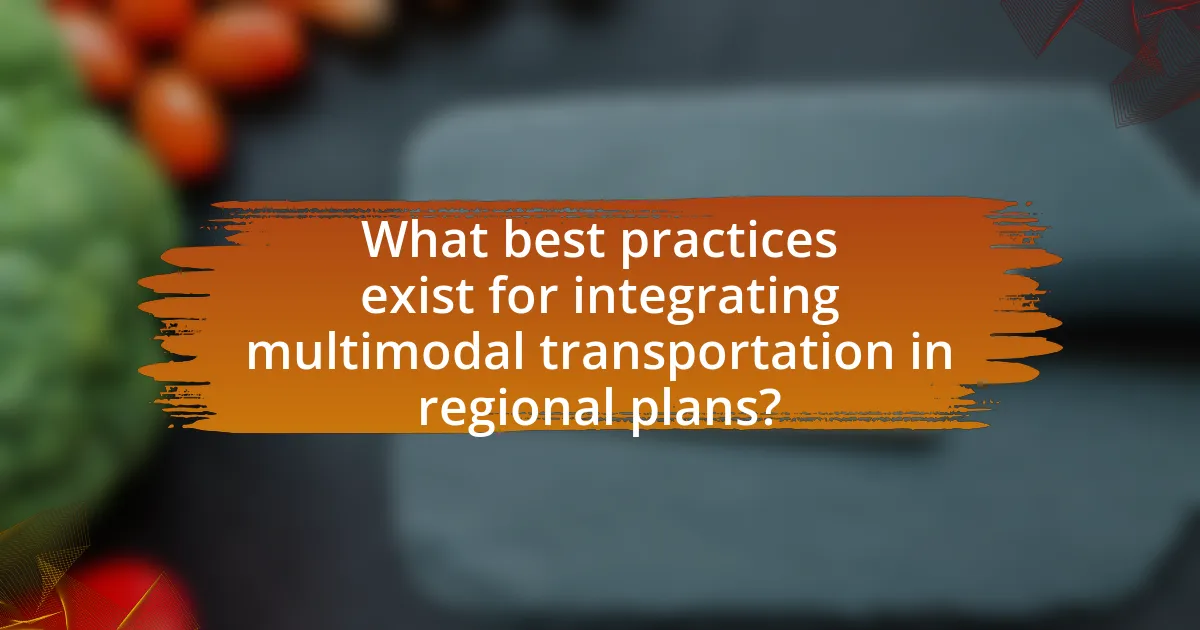
What best practices exist for integrating multimodal transportation in regional plans?
Best practices for integrating multimodal transportation in regional plans include establishing a comprehensive framework that promotes collaboration among stakeholders, ensuring connectivity between different modes of transport, and utilizing data-driven decision-making. Collaboration among local governments, transportation agencies, and community organizations fosters a unified approach, as evidenced by successful initiatives in cities like Portland, Oregon, where stakeholder engagement led to improved transit options. Ensuring connectivity, such as seamless transfers between buses, trains, and bike-sharing systems, enhances user experience and increases ridership, as demonstrated by the integration efforts in the San Francisco Bay Area. Data-driven decision-making, supported by tools like Geographic Information Systems (GIS), allows planners to analyze travel patterns and optimize routes, which has been shown to improve efficiency and reduce congestion in metropolitan areas.
What successful case studies demonstrate effective integration?
Successful case studies demonstrating effective integration of multimodal transportation options include the San Francisco Bay Area’s Regional Transportation Plan and the Netherlands’ Mobility as a Service (MaaS) initiative. The San Francisco Bay Area’s plan integrates various transportation modes, including buses, trains, and ferries, resulting in a 20% increase in public transit ridership over five years. The Netherlands’ MaaS initiative combines public transport, bike-sharing, and car-sharing services into a single platform, leading to a 15% reduction in car usage in urban areas. These examples illustrate how strategic planning and technology can enhance transportation integration and improve overall mobility.
What lessons can be learned from these case studies?
The lessons learned from case studies on integrating multimodal transportation options in regional plans include the importance of stakeholder collaboration, the need for data-driven decision-making, and the effectiveness of flexible policy frameworks. Stakeholder collaboration ensures that diverse perspectives are considered, leading to more comprehensive and accepted transportation solutions. Data-driven decision-making allows planners to assess the impact of various transportation modes and optimize resource allocation, as evidenced by successful implementations in cities like Portland, which utilized extensive data analysis to enhance its transit systems. Flexible policy frameworks enable regions to adapt to changing transportation needs and technologies, as demonstrated by the evolving strategies in cities like Amsterdam, which continuously refine their multimodal approaches based on real-time feedback and emerging trends.
How can these practices be adapted to different regions?
Practices for integrating multimodal transportation options can be adapted to different regions by assessing local demographics, geography, and existing infrastructure. For instance, urban areas may prioritize public transit and cycling infrastructure due to higher population density, while rural regions might focus on improving road connectivity and accessibility to public transport hubs. Additionally, stakeholder engagement is crucial; involving local communities in planning ensures that the solutions meet specific regional needs. Studies, such as the “Multimodal Transportation Planning: A Guide for Practitioners” by the Federal Highway Administration, highlight the importance of tailoring strategies to local contexts to enhance effectiveness and user acceptance.
What strategies can be employed to engage stakeholders in the planning process?
To engage stakeholders in the planning process for integrating multimodal transportation options in regional plans, strategies such as inclusive workshops, regular communication, and collaborative decision-making can be employed. Inclusive workshops allow stakeholders to voice their concerns and ideas, fostering a sense of ownership in the planning process. Regular communication through newsletters, social media, and public meetings keeps stakeholders informed and involved, ensuring transparency. Collaborative decision-making, where stakeholders participate in shaping the plans, enhances buy-in and commitment to the outcomes. Research indicates that stakeholder engagement improves project success rates by up to 30%, highlighting the effectiveness of these strategies in fostering collaboration and support.
How can community input shape multimodal transportation plans?
Community input can significantly shape multimodal transportation plans by ensuring that the needs and preferences of local residents are reflected in the planning process. Engaging the community through surveys, public meetings, and workshops allows planners to gather valuable insights on transportation challenges and desired improvements. For instance, a study by the American Planning Association found that projects incorporating community feedback are 30% more likely to succeed in meeting user needs. This direct involvement helps prioritize transportation modes, such as biking, walking, and public transit, based on actual usage patterns and community desires, ultimately leading to more effective and accepted transportation solutions.
What role do public-private partnerships play in successful integration?
Public-private partnerships (PPPs) play a crucial role in the successful integration of multimodal transportation options in regional plans by facilitating collaboration between government entities and private sector stakeholders. These partnerships leverage the strengths of both sectors, where public entities provide regulatory frameworks and funding, while private partners contribute innovation, efficiency, and expertise in project execution. For instance, the Federal Highway Administration has noted that PPPs can enhance project delivery timelines and reduce costs, as seen in various transportation infrastructure projects across the United States. By aligning the interests of both parties, PPPs enable the development of comprehensive transportation networks that effectively connect different modes of transport, ultimately improving accessibility and mobility for communities.
What are the future trends in multimodal transportation integration?
Future trends in multimodal transportation integration include increased use of technology for seamless connectivity, enhanced data sharing among transportation modes, and a focus on sustainability. Technology advancements, such as mobile applications and real-time data analytics, facilitate smoother transitions between different transportation modes, improving user experience. Data sharing initiatives, supported by smart city frameworks, enable better coordination among public transit, ridesharing, and active transportation options. Additionally, sustainability efforts drive the integration of electric and shared mobility solutions, aligning with global climate goals. These trends are supported by research indicating that cities adopting integrated multimodal strategies experience reduced congestion and improved air quality.
How is urbanization influencing transportation planning?
Urbanization is significantly influencing transportation planning by increasing the demand for efficient, multimodal transport systems that accommodate growing populations in urban areas. As cities expand, planners must integrate various transportation modes—such as public transit, cycling, and walking—into cohesive networks to reduce congestion and improve accessibility. For instance, the United Nations reported that by 2050, 68% of the global population is expected to live in urban areas, necessitating innovative transportation solutions to manage increased travel needs effectively. This shift towards urbanization compels transportation planners to prioritize sustainable practices, such as developing transit-oriented developments and enhancing infrastructure for non-motorized transport, thereby promoting environmental sustainability and improving quality of life in urban settings.
What innovations are on the horizon for multimodal systems?
Innovations on the horizon for multimodal systems include the integration of advanced data analytics, real-time connectivity, and autonomous vehicle technology. These innovations aim to enhance the efficiency and user experience of transportation networks. For instance, the use of artificial intelligence in data analytics allows for better demand forecasting and resource allocation, while real-time connectivity through mobile applications enables seamless transitions between different modes of transport. Additionally, the development of autonomous vehicles is expected to revolutionize last-mile connectivity, making multimodal systems more accessible and efficient. According to a report by the International Transport Forum, the adoption of these technologies could lead to a 30% reduction in travel time and a significant decrease in congestion in urban areas.
What practical steps can regions take to enhance multimodal transportation integration?
Regions can enhance multimodal transportation integration by developing comprehensive transportation plans that prioritize connectivity among various modes of transport. This includes creating dedicated infrastructure such as bike lanes, pedestrian pathways, and transit hubs that facilitate seamless transfers between buses, trains, and other transport options.
Additionally, implementing real-time data sharing systems can improve coordination and scheduling across different transportation services, making it easier for users to plan their journeys. For instance, cities like Amsterdam have successfully integrated cycling with public transport, resulting in increased usage of both modes.
Furthermore, engaging stakeholders, including local communities and businesses, in the planning process ensures that the transportation needs of all users are considered, leading to more effective and widely accepted solutions.
